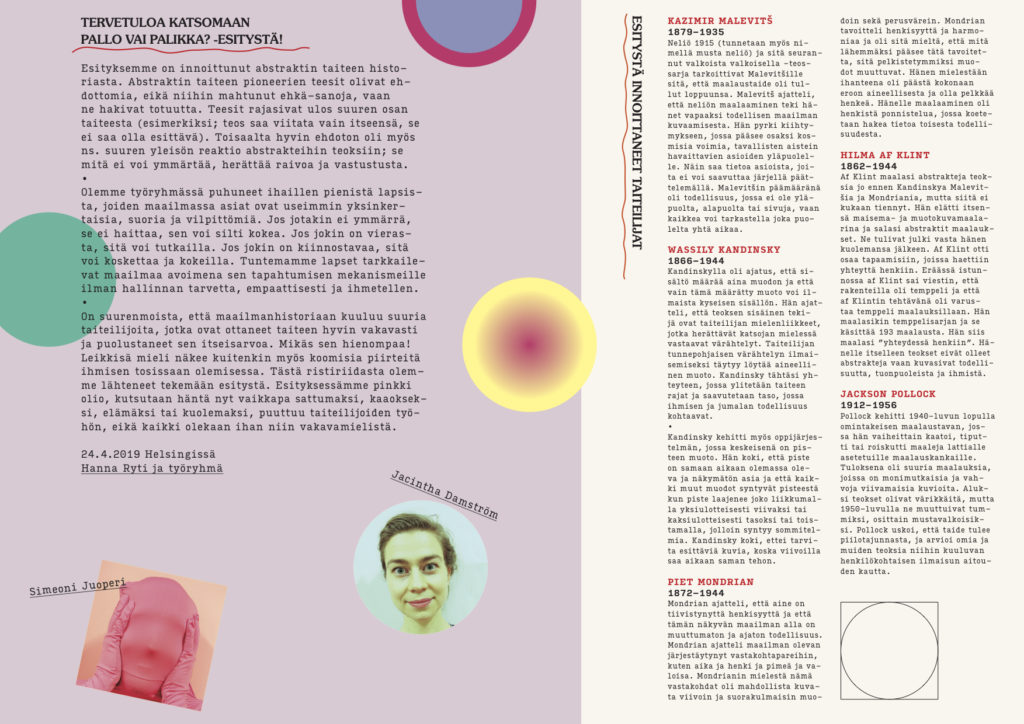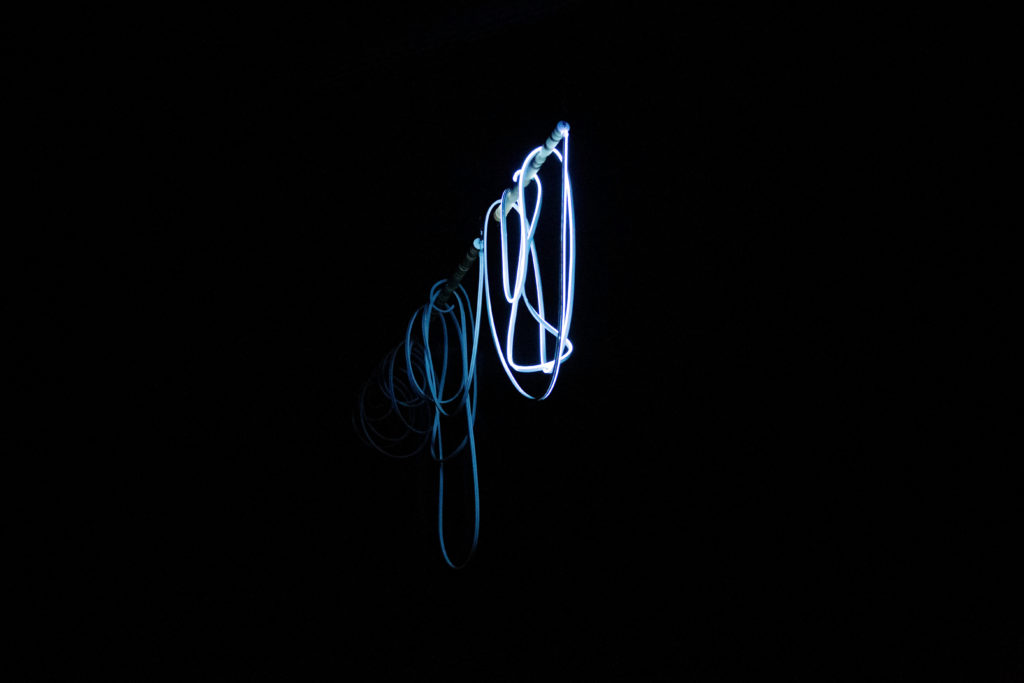Mehiläisten seura / Bee Company is an art collective interested in artistic work as situated knowledge under the precarious conditions of multispecies livelihoods.
Read more: mehilaistenseura.org
online portfolio
Mehiläisten seura / Bee Company is an art collective interested in artistic work as situated knowledge under the precarious conditions of multispecies livelihoods.
Read more: mehilaistenseura.org
Work group – Hanna Ryti, Ina Niemelä, Silja Kauppinen, Ville Leppilahti, Simeoni Juoperi, Jacintha Damström
Premiere in Hurjaruuth 24.4.2019 at Ruutia! festival.
Speechless contemporary circus performance, for people over 3 years, of the ideas of abstract art by Malevitš, Kandinsky, Mondrian, Af Klint, Pollock and the pink creature.
Duration 50min

Photos Silja Kauppinen
Performers:
Amanda Kauranne – voice, percussions, wind instruments, double bass
Helmi Camus – voice, double bass, keayboard instruments
Minna Koskenlahti – voice, percussions, wind instruments
Sini Siipola – dance, choreography, voice, percussions
Verta concert featured by Maija Kauhanen – kantele, voice
Propagandaa concert featured by Hildá Länsman or Pirita Näkkäläjärvi – yoik, voice, kantele
Concept – Amanda Kauranne
Live sound – Pauliina Saarman
Lights and projections -Ina Niemelä
Assisting director – Elina Lajunen
Production – Mari Pääkkönen
Logo – Paula Susitaival
Verta premiere in 19.3.2018 in Space for free arts (old air-raid shelter)
Pornoa premiere in 1.9.2018 in Lapinlahti Hospital
Propagandaa premiere in 18.9.2018 in SKS, Centre for Finnish Literature
JUMALAUTA! premiere in 20.1.2019 in Music theatre Kapsäkki
Supported by Kone Foundation, MES, Arts Promotion Centre Finland, City of Helsinki, Heluna Shop
Duration 4 x 90min
More information: vppj2018@gmail.com
VPPJ! won the phenomenon of the year price in Etnogaala 2020
Verta (Blood) starts a feminist folk music concert serie Verta, pornoa ja propagandaa, JUMALAUTA! The first concert explores the blood line, menstrual fluid and child birth blood, as well as blood shed throughout the centuries, aggression as a destroying and creative force. The mood of the performance swings between bang and clatter, small and sensitive, amusing and frightening.
Different Finnish folk music traditions and stories from murder ballads to childbirth spells, from old hymns to ancient catfights are played.
Pornoa (Porn) concert celebrates sexuality, body and the wandering mind.
Traditional love chants, old runosongs about the hatered and powers of the cunt, folk songs of the genitalian joys and new compositions to enrich the variety sexy songs are combined with movement and surprising performance art. If Steve Vai’s guitar solo makes one think of male ejaculation what could be the female equivalent as a musical act.
Propagandaa (Propaganda) concert investigates the nature of propaganda with the means of performance and song. What kind of propaganda has been used to depict the ideal woman in the course of history, what has been censored and how folk music was harnessed for the Finnish narrative? What is propaganda today?
In the concert one hears songs from the era of civil war, yoiks, lyrics made from the room flat for a young woman, as well as internet trolling and hate talk concidering Blood concert transformed into songs lyrics.
JUMALAUTA! contemplates the concept of holy and looks into the archaic and newer systems of beliefs. What divides material and spiritual? What was the role of a woman in the history of religions?
Violence, sexuality, propaganda songs and the experience of sacred – in 2018-2019 the concert serie takes up topics that are widely sung in the historical folk music, but are rarely sang today with a female voice. If we remain silent about these issues, what kinds of representations of women manifest or have been manifested? What happens if we give a voice to them?
Photos Sanna Breilin
Dál lea vejolaš gullat olles feministalaš álbmotmusihkkakonseartaráiddu Varra, porno, propagánda, JUMALAUTA! Konseartaráidu ovdána syklalaččat. Dat addá ođđasit jiena olmmošeallima áššiide, mat leat muhtumin čiekŋalat ja muhtumin fas geahppasat. Perspektiiva lea nissonin navdojuvvon olbmuid geahččanguovlu.
Varra-konsearta dutká eallima láiggi, man ng. varraárbi, mánodávdavarra ja mánáriegádahttinvarra duddjojit. Lassin konsearta guorahallá vara golggaheami ja vel aggreššuvnna. Dát leat fámut, mat sihke duššadit juoidá ja duddjojit ođđa nissonolbmo eallimis. Bargojoavkku ovddabealde rahpasa ovttalágan veahkaválddi kataloga maŋimus čudiid jagiid áigge. Mii álggahit vuohttunlávlagis ja loahpahit riegádahttinlohkosii – jos veahkaválddi ii botke, nu joatkášuvvágo dat?
Porno-konsearta gieđahallá seksualitehta girjáivuođa ja máŋggabealátvuođa. Seksualitehta birra leat olbmot lávlon álo. Mii goittotge buktit dasa ođđa geahččanguovllu: feministalaš perspektiivva, nissonin navdojuvvon olbmo historjjá ja geahččanguovllu, mii rahpá dálá áiggi. Mii álggahit diktalávlumiin ja ovdánit das cinná vašiin ja fámuin gitta 2010-logu seksualitehta govaide ja dan deaddagiidda.
Progagánda-konsearta dutká dáidaga bokte, ahte makkár propagánda olbmot leat don doloža rájes gullan ja buvttadan. Mo propagánda báidná nissongova iešguđet áigodagas? Mo álbmotmusihkka ja árbevierut leat ávkkástallojuvvon, go muitalus Suoma birra lea huksejuvvon? Main áššiin dán áigge galggašii lávlut dahje jávohuvvat?
JUMALAUTA!-konsearta suokkarda basi vásáhusa ja dutkada dološsuopmelaš ja dan maŋŋá boahtán oskumušortnega. Mii earuha eatnanlačča ja vuoiŋŋalačča? Mo nissonolbmot vásihedje vuoiŋŋalašvuođa dolin, go almmáiolbmot dávjá hálddašedje oskkoldagaid virggálaččat?
Choreography, performance – Jenni-Elina von Bagh
Scenography – Ingvill Fossheim
Lighting design – Ina Niemelä
Sound design and composition – Tom Lönnqvist
Realization of the sound in collaboration with Johannes Vartola
Dramaturge – Otto Sandqvist
Corporeal assistant – Virpi Nieminen
Residencies – Kutomo, Ehkä-tuotanto, Teisko-radicalisation
Production – Zodiak, Jenni-Elina von Bagh
Premiere at the Zodiak Stage 25.2.2020
Duration 50min
Performance language English
Jenni-Elina von Bagh’s solo performance A Prologue explores the relationship of the multi-layered body and the about-to-happen, the unknown. It probes what it feels like to live in this time, how the present confusion and the state of the world are connected to art, dance, our bodies and our senses. What is the moment right before the moment?
A Prologue is a site of dynamic flows that seek release from the habitual patterns of the mind and from reactive behaviours. It surrenders to expressive dimensions, where also laughter is an attractive possibility. In its wider frame of reference it is inspired by philosophical thinking that argues that the power of life permeates life, death, human and non-human.
The performance explores borderlines and gaps, regarding the subject as something constantly changing and transforming, connected to both the present and the past. A Prologue is also a dialogue between two professional identities: that of the performer and that of the choreographer. (www.zodiak.fi)
Photos Katri Naukkarinen

Teos tunnustelee sitä miltä tuntuu elää tässä ajassa ja samalla antautua elämänvoiman kysymykselle. Mitä elämän voima on? Miten sen lävistää ihmisen ulottuen tulemisen tapahtumalle, joka myös ylittää ihmisen.
Olemme työryhmänä käsitelleet erityisesti Henri Bergsonin filosofista käsitettä elan vital. Käsitteen uudellen käännös voisi olla meidän ajassamme näyttämöllisten komponenttien törmäys ja taitos kohti laajempaa posthumanistista maisemaa ja mahdollisuutta uusien reittien luomiselle.
Soolona teos tunnustelee yhden esiintyjän ruumiin, tietyn historian ja kokemusavaruuden omaavaa komponenttia. Se leikittelee eri tendensseillä ja rooleilla, jotka puristuvat ja avautuvat tästä ulottuvuudesta kohti näyttämötapahtumaa. – Jenni-Elina von Bagh
Borderlines and gaps. Life, death, human, non-human. Material explored stenographically include fossilized traces of ancient worms, repurposed human hair and medical implants, plastics and rubber, glass and sand and soil, salvaged wood and metal. The colored textiles, hair, string and wood are dyed with bio based colourants, involving processes of fermentation and microbial interference. –Ingvill Fossheim
“Kun yhteiskunta ajautuu kriisivaiheeseen tai lähestyy romahdusta, mahdollisuuksien horisontti avautuu. Sitä on kuitenkin vaikea erottaa, ja siihen rajautuvaa maastoa on vaikea kuvailla ja kartoittaa. Mahdollisuuksien horisonttia voidaan luonnehtia parhaiten lainaamalla Ignacio Blancon määritelmää tiedostamattomasta: “Tiedostamaton on tekemisissä rajattomien tapahtumasarjojen kanssa, joiden voima ei kumpua vain laskelmoitavuudesta vaan myös jatkumoista.” 11 Semiootisen sfäärin räjähdys ja semiootisen simulaation läpikotainen voimistuminen ovat yhtäältä laajentaneet mahdollisuuksien horisonttia ja toisaalta ajaneet yhteiskunnallisen hermojärjestelmän paniikkiin. Järki ei kykene paniikin vallitessa hallitsemaan tapahtumien virtauksia ja käsittelemään infosfääriin leviävää semiostimulaatiota. Skitsofrenia on läpäissyt yhteiskunnallisen mielen. Sen aiheuttama ahdinko on kuitenkin kaksiteräistä: se on kivuliaalla tavalla kaoottista, mutta samalla se on mahdollista ymmärtää myös värähtelyksi, joka ennakoi uuden älyllisen rytmin löytymistä.”
Mahdollinen tulevaisuus ja voimattomuuden aika, Franco “Bifo” Berardi (Tutkijaliitto 2019), s. 3111 Ignacio Matte Blanco, The Unconscious as Infite Sets: An Essay in Bi-logic (1975), s. 17
A Prologuen valo saa rytminsä mm. tästä Franco “Bifo” Berardin lainauksesta. Valosuunnittelu koostuu pääosin transrationaalisista käännöksistä: tekstistä, äänistä ja nauhoituksista valoksi. Käännökset on toteutettu yksinkertaisella dataprosessoinnilla ja signaalinmuunnoksilla hyödyntäen “graafisen” valosuunnittelun mahdollisuuksia. – Ina Niemelä
critiques in finnish and swedish“What is the atonal composition of time wa can’t see? Does electricity respond to it? ” – Tom Lönnqvist